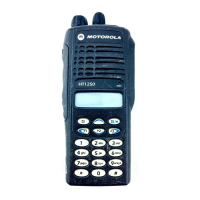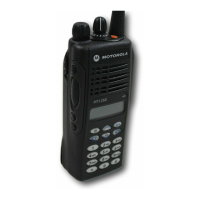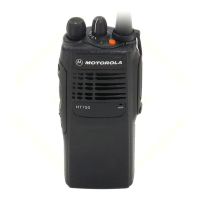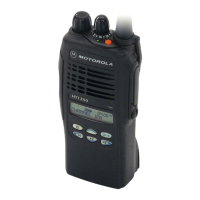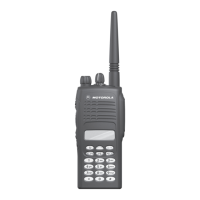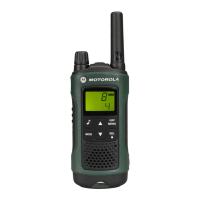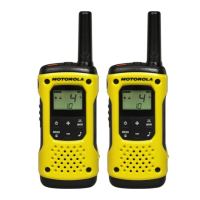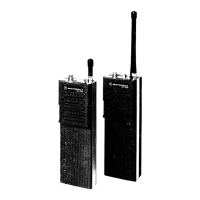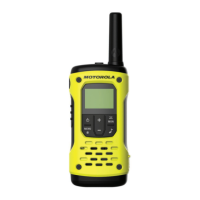Do you have a question about the Motorola HT1550-XLS and is the answer not in the manual?
Guidelines for safe usage and RF exposure compliance.
Identification of the radio's physical components and controls.
Explanation of LED colors and their meanings during operation.
Details on connecting accessories via the side connector.
Overview of programmable buttons and their functions.
Detailed explanation of symbols displayed on the LCD screen.
Details on battery types, charging procedures, and status indicators.
Methods to check the battery charge level on the radio.
Step-by-step instructions for battery installation and removal.
Procedures for attaching and detaching the radio's antenna.
Instructions for securing and removing the belt clip.
Steps to install the cover for the side connector.
Procedure for powering the radio on and off.
Setting and using the radio's password for security.
How to control the audio volume of the radio.
Navigating and selecting between different radio zones and talkgroups.
Methods for choosing radio zones using menus or the selector knob.
Procedures for choosing specific channels or talkgroups.
Steps to initiate a call on a conventional channel.
Steps to initiate a call on a trunked system.
How to receive incoming radio calls.
How to place a private call to a specific radio or group.
How to handle incoming selective calls.
How to send a notification or alert to another radio.
Procedures for managing radio text or data messages.
How to transmit a high-priority emergency notification.
Accessing and clearing the list of missed calls.
Steps to edit names associated with radio IDs.
Adjusting squelch for filtering unwanted noise.
Adjusting radio power for transmission range and battery life.
Assigning specific tones to individual radio users.
Assigning specific tones to different types of radio calls.
Sending and receiving prearranged status messages.
Procedures for making and handling emergency calls.
Placing prioritized calls and group broadcast calls.
Using DTMF for telephone system interaction.
How to use Auto Group Scan on LTR systems.
How to scan all talkgroups in an LTR zone.
How to scan trunked and conventional channels.
Temporarily removing unwanted channels from scan lists.
Adding, deleting, or prioritizing channels in scan lists.
Procedures for modifying scan list entries.
Setting channel priority for more frequent monitoring.
Steps to initiate phone calls on LTR trunked systems.
Steps to initiate phone calls on conventional systems.
How to answer incoming phone calls.
Adding, deleting, or editing phone numbers in the list.
Removing phone numbers from the stored list.
Modifying existing phone number entries.
Table showing available recording time slot configurations.
Recording incoming radio transmissions.
Setting up automatic recording of all incoming calls.
Recording personal voice memos or reminders.
Listening to previously recorded messages.
Deleting stored voice messages.
Transmitting recorded messages to other radios.
Sending automated replies to selective calls.
Navigating menus to adjust audio and tone settings.
Details on specific audio and tone settings like volume, disable, tagging, etc.
Navigating menus to adjust utility settings.
Configuring radio lock, squelch, and power levels.
Adjusting display light, checking software, and managing auto reply.
Adjusting the current time displayed on the radio.
Instantly accessing favorite channels via a button.
Automating channel access and PTT-ID transmission on LTR systems.
Explains what the warranty covers and for how long.
Outlines general terms, remedies, and liability limitations.
Procedures and requirements for getting warranty service.
Lists conditions and damages not covered by the warranty.
List of compatible antennas for the radio.
List of compatible batteries for the radio.
List of compatible chargers for the radio.
List of compatible audio accessories like microphones.
List of compatible headsets for the radio.
Details on CommPort microphone and receiver systems.
List of available surveillance kits.
Various earpieces and EMS components.
Interface modules and adapter cables for accessories.
Guidelines for safe usage and RF exposure compliance.
Identification of the radio's physical components and controls.
Explanation of LED colors and their meanings during operation.
Details on connecting accessories via the side connector.
Overview of programmable buttons and their functions.
Detailed explanation of symbols displayed on the LCD screen.
Details on battery types, charging procedures, and status indicators.
Methods to check the battery charge level on the radio.
Step-by-step instructions for battery installation and removal.
Procedures for attaching and detaching the radio's antenna.
Instructions for securing and removing the belt clip.
Steps to install the cover for the side connector.
Procedure for powering the radio on and off.
Setting and using the radio's password for security.
How to control the audio volume of the radio.
Navigating and selecting between different radio zones and talkgroups.
Methods for choosing radio zones using menus or the selector knob.
Procedures for choosing specific channels or talkgroups.
Steps to initiate a call on a conventional channel.
Steps to initiate a call on a trunked system.
How to receive incoming radio calls.
How to place a private call to a specific radio or group.
How to handle incoming selective calls.
How to send a notification or alert to another radio.
Procedures for managing radio text or data messages.
How to transmit a high-priority emergency notification.
Accessing and clearing the list of missed calls.
Steps to edit names associated with radio IDs.
Adjusting squelch for filtering unwanted noise.
Adjusting radio power for transmission range and battery life.
Assigning specific tones to individual radio users.
Assigning specific tones to different types of radio calls.
Sending and receiving prearranged status messages.
Procedures for making and handling emergency calls.
Placing prioritized calls and group broadcast calls.
Using DTMF for telephone system interaction.
How to use Auto Group Scan on LTR systems.
How to scan all talkgroups in an LTR zone.
How to scan trunked and conventional channels.
Temporarily removing unwanted channels from scan lists.
Adding, deleting, or prioritizing channels in scan lists.
Procedures for modifying scan list entries.
Setting channel priority for more frequent monitoring.
Steps to initiate phone calls on LTR trunked systems.
Steps to initiate phone calls on conventional systems.
How to answer incoming phone calls.
Adding, deleting, or editing phone numbers in the list.
Removing phone numbers from the stored list.
Modifying existing phone number entries.
Table showing available recording time slot configurations.
Recording incoming radio transmissions.
Setting up automatic recording of all incoming calls.
Recording personal voice memos or reminders.
Listening to previously recorded messages.
Deleting stored voice messages.
Transmitting recorded messages to other radios.
Sending automated replies to selective calls.
Navigating menus to adjust audio and tone settings.
Details on specific audio and tone settings like volume, disable, tagging, etc.
Navigating menus to adjust utility settings.
Configuring radio lock, squelch, and power levels.
Adjusting display light, checking software, and managing auto reply.
Adjusting the current time displayed on the radio.
Instantly accessing favorite channels via a button.
Automating channel access and PTT-ID transmission on LTR systems.
Explains what the warranty covers and for how long.
Outlines general terms, remedies, and liability limitations.
Procedures and requirements for getting warranty service.
Lists conditions and damages not covered by the warranty.
List of compatible antennas for the radio.
List of compatible batteries for the radio.
List of compatible chargers for the radio.
List of compatible audio accessories like microphones.
List of compatible headsets for the radio.
Details on CommPort microphone and receiver systems.
List of available surveillance kits.
Various earpieces and EMS components.
Interface modules and adapter cables for accessories.
| Brand | Motorola |
|---|---|
| Model | HT1550-XLS |
| Category | Two-Way Radio |
| Language | English |
